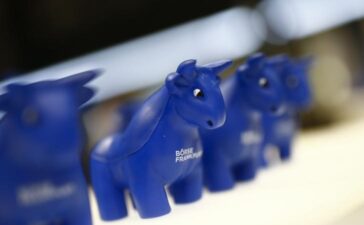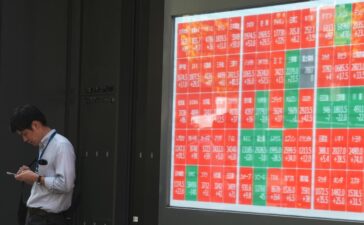By Li Gu and Vidya Ranganathan
SHANGHAI (Reuters) – China’s plunging stock market is leading to losses on billions of dollars worth of derivatives linked to the country’s equity indexes, fuelling further selling as retail investors offload their positions.
Stock markets in Hong Kong and on the mainland plunged on Monday, extending a long spell of weakness driven by an exit of foreign investors alarmed by China’s wobbly economy.
Share prices stabilised somewhat on Tuesday after authorities announced plans to support the market, but analysts were hesitant to cheer.
The small-cap CSI1000 index has traded below the 5,000 level this week, after a 6% plunge on Monday to its lowest level in nearly four years.
Market participants said the drop triggered “knock-in” levels on “snowball” products, also known as “auto-callables” in some markets, leading to forced selling of stock futures contracts which further pressured the market.
“Futures volumes have been elevated, around 50% higher than average yesterday, for example,” said Jon Withaar, who manages an Asia special situations hedge fund at Pictet Asset Management. That showed these products had been hedged via stock futures, he said.
“Snowballs” are derivatives in which investors receive a bond-like coupon if the underlying assets, such as the CSI500 and CSI1000 indexes, do not hit a pre-determined “knock-in” level.
They were popular among investors until recently, when such knock-ins started happening more often as indexes fell.
Analysts at UBS estimate the outstanding notional amount in such products is around $50 billion and that roughly 40% of knock-ins have likely been hit.
Brokerage China International Capital Corp (CICC) estimated the average knock-in levels for many snowball products tied to the CSI500 and CSI1000 are at 4,865 and 4,997, close to where the indexes are.
Analysts at Bank of America said Snowball was one of the reasons for the stock market drop, and a drag on the already weak stock market. The bank estimates a further 6% to 7% decline in the CSI500 or CSI1000 indexes will trigger another round of knock-ins.
One retail investor Mr Shi, who asked to be identified only by his last name, said he invested one million yuan ($139,466) in snowballs tied to CSI1000 index and discovered his products had hit the knock-in level on Monday.
When he bought the two-year products in early 2023, he was expecting to earn a return of at least 8%. But now, unless the index rises above the 7,000-level within a year — implying a 40% rise from current levels — he will earn no coupon and also lose some of his principal.
Meanwhile, as knock-in levels are being hit, brokers are selling stock index futures to hedge their exposures.
Futures contracts on CSI1000 due in Sept 2024 fell by the daily maximum limit of 10% on Monday to levels 8% below where the index was trading.
Futures contracts tied to CSI1000 due in February saw turnover spike to 93 billion yuan on Monday. That compares to an average of daily turnover of 13 billion yuan in the past month.
Zhou Zhiyang, a fund manager at Jiahe Private Fund Management, said the divergence between futures prices and spot prices was drawing in arbitrageurs, seeking to profit by selling spot markets and buying futures contracts.
Snowball products are similar to the index-linked products sold in the 2008 financial crisis, with investors betting that U.S. equities would not fall more than 25% or 30%, David Huang, senior investment strategist at AllianceBernstein, said at a press briefing last Friday.
“And it turned out, what you think wouldn’t happen, ended up happening. This also shows that A-shares may indeed be on their last round of falls,” Huang said, suggesting that the exit by some of the market’s most conservative investors could mean share prices are nearing a bottom.
($1 = 7.1702 Chinese yuan renminbi)
(Reporting by Li Gu in Shanghai and Vidya Ranganathan in Singapore; Additional reporting by Summer Zhen in Hong Kong and Ankur Banerjee in Singapore; Editing by Kim Coghill)

















